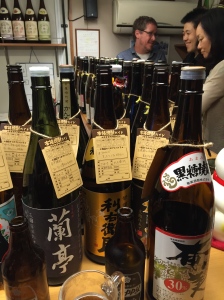The more acquainted I get with shochu, the more I realize how much more there is to learn about it. It’s such an easy beverage to like, but not such an easy one to know.

In 2015, I’ve traveled to Japan twice—mostly to the epicenter of shochu production, the southern island of Kyushu—with the express purpose of exploring the elusive spirit that gets a chapter-long shout-out in The Year of Drinking Adventurously (my new book, due out in a little over three weeks—pre-order today).
Back in March I toured several shochu distilleries, dined with their proprietors and made a circle of new friends whose common bond is a passion for the drink. In October, I returned to Kyushu (thanks to the Japan Sake and Shochu Makers Association and Kampai.US mastermind Stephen Lyman) for a bigger, bolder sequel to that spring experience.

I thought I had pretty much gotten my head around it on that first trip.
I discovered that there’s no single right way to drink it: on the rocks (my personal preference), as a 50/50 water/shochu mix (heated or cold), combined with green tea, in a cocktail or neat. Well, this time around, I learned that that list wasn’t quite complete and that we should add “with a grilled flying fish steeping in it.”
Last time, I drank shochus made from the five main bases: sweet potatoes, rice, barley, buckwheat and black sugar. Those bases, by the way, are very much regional in nature. Go to the Kagoshima prefecture and you very likely won’t be drinking anything other than sweet potato (imo) shochu (one of the distilleries there even put me to work briefly, cutting sweet potatoes and stirring the mash). Go to Kumamoto and rice is the base of choice. The borders get a little blurred after that, but generally speaking, Miyazaki prefecture is good for buckwheat-based shochu and Oita is a hotbed for barley shochu (but you’ll find distillers dabbling in many different bases, regardless of region). The small archipelago of Amami Oshima is known for black sugar shochu.
And then there are the less common bases. I’d heard that there are some 50 different grains and vegetables from which sake may be made, but, aside from sesame, I hadn’t tried any of them (the sesame-based one that I’ve had, by the way, is the absolutely delightful Beniotome, produced in the Fukuoka prefecture). To me, all of those other bases were like urban legends. I knew that you could make shochu out of carrots, but, naively, I didn’t think too many distillers actually did.
I finally did taste them—not in any of the prefectures of Kyushu, but in Tokyo (among the best places to do so is Bar Gen, which, when I visited had around 5,700 different shochus in stock. The bar posts a running tally). Not only did I get to taste a carrot shochu, but I sampled varieties made from tomatoes, shitake mushrooms, shiso and even milk.
I feel like my grasp of this revered Japanese spirit has gotten stronger after this most recent visit to its country of origin. But I also believe that on my next trip (which I hope will be sooner rather than later), the future me will accuse the present me of having much in common with Jon Snow.

Reblogged this on Whiskey And Whisky For The Everyday Man and commented:
Not Whisk(e)y related, but this has definitely peaked my interest!
LikeLiked by 1 person
So, what is shochu? Is it clear, aged, like Saki? What kind of flavor profiles does it have, and is it available stateside? You have definitely peaked my interest.
LikeLike
It’s clear, occasionally it’s aged, but most of the time it’s not (when it is, it’s in rare instances aged in barrels; more often it’s matured in clay pots or stainless steel, allowing the spirit to retain the flavor of the base ingredient without being overpowered by wood). The better ones are distilled only once, retaining much of the character of the base ingredient. The big distinguishing factors with sake are that it’s distilled (where sake is brewed and fermented without distillation) and while many shochus are made from rice, there are many more that aren’t (sweet potatoes, barley, buckwheat, black sugar are the most common). It is available in the states. On-premise it’s mostly available in Japanese restaurants or izakayas. Off-premise it can be found in the larger liquor stores, as well as specialty shops.
LikeLike